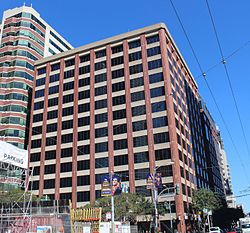 | |
| Formation | July 29, 1927 |
|---|---|
| Type | Unified bar |
| Headquarters | San Francisco, California, United States |
Membership | 286,809[1] |
| Website | calbar.ca.gov |
The State Bar of California is an administrative division of the Supreme Court of California which licenses attorneys and regulates the practice of law in California.[2] It is responsible for managing the admission of lawyers to the practice of law, investigating complaints of professional misconduct, prescribing appropriate discipline, accepting attorney-member fees, and financially distributing sums paid through attorney trust accounts to fund nonprofit legal entities. It is directly responsible to the Supreme Court of California. Its trustees are appointed by the Supreme Court, the California Legislature, and Governor of California.[3] All attorney admissions are issued as recommendations of the State Bar, which are then routinely ratified by the Supreme Court.[4] Attorney discipline is handled by the State Bar Office of Chief Trial Counsel, which acts as prosecutor before the State Bar Court of California.[5] The State Bar has been cited for its corrupt practices during the 21st century, and is subject to reforms issued by its governing body, the California Supreme Court.[6][7]
The State Bar was legally established on July 29, 1927, when the State Bar Act went into effect.[8]: xiii–xix The State Bar of California is the largest in the United States, with over 286,000 living members as of December 2022, of whom nearly 197,000 are on active status.[1] It is headquartered in San Francisco, with a branch office in Los Angeles.

At its inception, the State Bar was a "unified" bar in which disciplinary functions and more traditional "bar association" functions were joined into one entity. In 2018–2019, the State Bar was split into two entities: the State Bar of California became a standalone Government entity with legal enforcement via the State Bar Court.[9][10]
The new entity split off from the State Bar of California became the California Lawyers Association (CLA) and took over certain functions such as education, lobbying, and annual meetings. Membership in the CLA is voluntary. Membership in the State Bar of California is mandatory for most practicing lawyers in California (the only exceptions being for very specific instances). The CLA is an NGO (Non-governmental organization).[11]
- ^ a b "Attorney Demographics". State Bar of California. Retrieved December 15, 2022.
- ^ http://www.calbar.ca.gov/ State Bar of California, Official Website, accessed, June 22, 2020.
- ^ "Supreme Court makes 2019 appointments to State Bar Board of Trustees". California Supreme Court Press Release. September 3, 2019. Archived from the original on August 16, 2022.
- ^ Cal. Business & Professions Code § 6064 (empowering State Bar to certify admission of applicants)
- ^ See also Hallinan v. Committee of Bar Examiners, 65 Cal. 2d 447 (1966) (Supreme Court may override State Bar's finding of lack of good moral character and force State Bar to certify applicant for admission) and Pineda v. State Bar, 49 Cal. 3d 753 (1989) (Supreme Court may override State Bar's recommendation of punishment and prescribe more severe punishment). Notably, Terence Hallinan went on to become San Francisco's district attorney, while Lynn Pineda was disbarred by the Supreme Court of California on September 14, 1990.
- ^ Cite error: The named reference
Cutler 2023 l905was invoked but never defined (see the help page). - ^ Cite error: The named reference
Sloanwas invoked but never defined (see the help page). - ^ "Introductory: The Genesis and Development of the State Bar", in the Proceedings of the First Annual Meeting of the State Bar of California (San Francisco: The Recorder Printing and Publishing Co., 1929), xvi.
- ^ "The State Bar Court of California Home Page".
- ^ Hiltzik, Michael (June 17, 2016). "Column: The California State Bar's dismal history shows why it should be broken up". Archived from the original on November 10, 2022.
- ^ "California Split: 1 year after nation's largest bar became 2 entities, observers see positive change". Archived from the original on December 3, 2022.